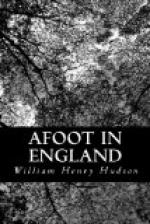The watching was not wholly in vain, since there were here revealed to me things, or aspects of things, that were new. A great deal depends on atmosphere and the angle of vision. For instance, I have often looked at swans at the hour of sunset, on the water and off it, or flying, and have frequently had them between me and the level sun, yet never have I been favoured with the sight of the rose-coloured, the red, and the golden-yellow varieties of that majestic waterfowl, whose natural colour is white. On the other hand, who ever saw a carrion-crow with crimson eyes? Yet that was one of the strange things I witnessed on the Otter.
Game is not everywhere strictly preserved in that part of Devon, and the result is that the crow is not so abhorred and persecuted a fowl as in many places, especially in the home counties, where the cult of the sacred bird is almost universal. At one spot on the stream where my rambles took me on most days a pair of crows invariably greeted my approach with a loud harsh remonstrance, and would keep near me, flying from tree to tree repeating their angry girdings until I left the place. Their nest was in a large elm, and after some days I was pleased to see that the young had been safely brought off. The old birds screamed at me no more; then I came on one of their young in the meadow near the river. His curious behaviour interested me so much that I stood and watched him for half an hour or longer. It was a hot, windless day, and the bird was by himself




